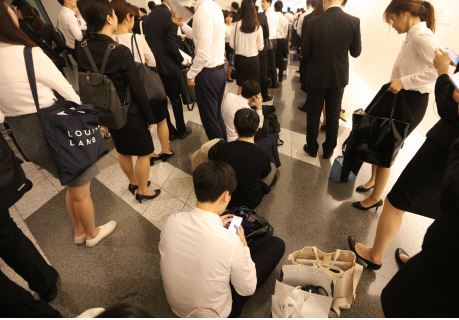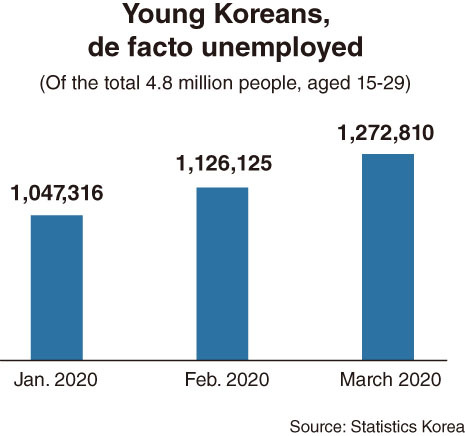 |
Jobseekers wait in line for an interview during a joint recruitment fair in Seoul, which is arranged by major financial services firms. (Yonhap) |
SEJONG -- The COVID-19 disaster has added to mass youth unemployment, which had already been a critical social issue over the past few years.
According to the Supplementary Index for Employment III, held by Statistics Korea, de facto unemployment for those aged 15-29 reached 1.272 million among the extended-based economically active population of 4.785 million.
This figure means a surge by about 225,000 people in only two months, compared to January, when the tally stood at 1.047 million.
The Supplementary Index III for Employment, a relatively new state method for calculation, regards “underemployed” people -- who work less than 36 hours a week and want to work more hours, as well as seasonal workers who are out of work for part of the year -- as jobless.
The figure for March indicates that more than 1 in 4 young people are unemployed.
The figure contrasts with the “official” numbers publicized by the government for the month, which have total youth unemployment at 402,000, or 9.9 percent. The official government data is calculated in a conservative manner, by not regarding a large portion of temporary workers as the jobless.
 |
(Graphic by Kim Sun-young/The Korea Herald) |
Between January and March, the extended youth jobless rate grew steeply -- from 21.4 percent in January to 23.1 percent in February (de facto unemployed totaling 1.126 million), and to 26.6 percent in March (the all-time high since the nation started compiling the data in January 2015).
On Wednesday, President Moon Jae-in pledged to create 550,000 jobs, in a 10 trillion won ($8.1 billion) plan using mostly taxpayers’ money.
But many online commenters criticized the scheme, predicting it would just create many temporary jobs in the public sector and calling it another waste of taxpayer money.
The Moon administration, since taking office in May 2017, has spent about 50 trillion won on job creation, reflecting its electoral pledge to make 810,000 jobs in the public sector and resolve the youth unemployment simultaneously.
But these efforts produced a number of temporary jobs for seniors in their 60s or over at state-funded agencies, rather than increasing regular jobs for the young generation.
From May 2017 to March 2020, the extended youth jobless rate stayed over 20 percent for the 35th consecutive month. Former record high before COVID-19 was 25.2 percent, posted in April 2019.
Many economists attribute the high youth jobless rate to a drastic hike in the minimum wage, which aggravated labor costs for small businesses. The monthly minimum wage, which was 1.35 million won in 2017, climbed to 1.74 million won in 2019.
This comes as part of the Moon government’s policy of income-led growth, despite mounting criticism.
An issue is whether President Moon will stick to the income-led economic policy in his remaining 25-month term. The next presidential election will be conducted in 23 months.
By Kim Yon-se (
kys@heraldcorp.com)








![[Today’s K-pop] Blackpink’s Jennie, Lisa invited to Coachella as solo acts](http://res.heraldm.com/phpwas/restmb_idxmake.php?idx=644&simg=/content/image/2024/11/21/20241121050099_0.jpg)
